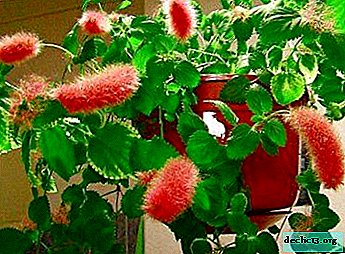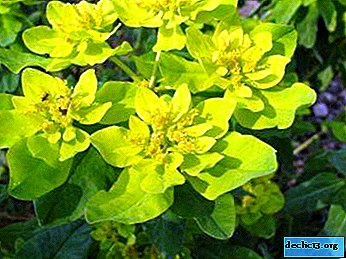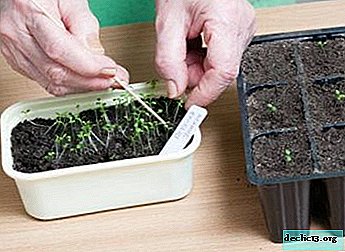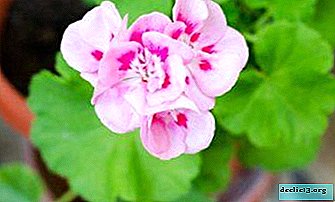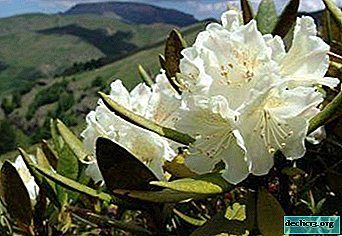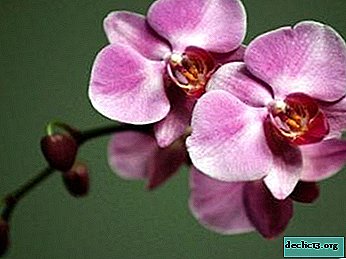What is a mealybug and how to deal with it on indoor plants?
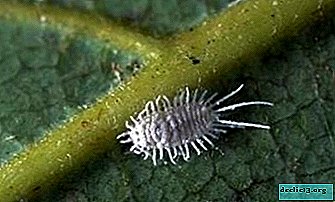
This pest is also called fluffy louse - because of the whitish waxy discharge, similar to cotton wool, which it leaves on indoor plants.
Scientifically, his name is mealybug, and he is able to harm even the most well-groomed flowers.
You can fight the worm with chemicals or folk remedies. It will be possible to withdraw, if you do not miss the moment.
What it is?
Mealybug is an insect visible to the naked eye (individuals reach up to 8 millimeters). Signs that the plant was attacked: the flowers suddenly “turned white”, began to fade, a white, cotton coating appeared on the leaves.
Pests suck out the juices from the flower, and thereby lead him to death. Insects are able to move from plant to plant.The main causes of the appearance of the worm:
- In the soil there are larvae or eggs of an insect. They can even be found in store soil. Therefore, it is necessary to carry out the cultivation of the earth in order to disinfect it before planting the plant, placing it for several minutes in the microwave or at night in the freezer.
- The insect moved from another flower. To avoid this, you must always separate the newly arrived plant in the quarantine zone and monitor its condition for almost a month. With any signs of the disease - treat.
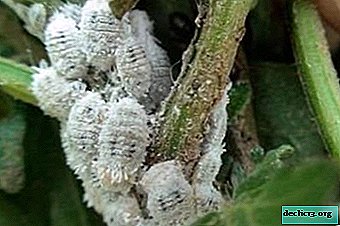 The worm comes from improper care - in a room too cold for the flower or if the plant was watered with very cold water or water of inappropriate (for example, too warm) temperature.
The worm comes from improper care - in a room too cold for the flower or if the plant was watered with very cold water or water of inappropriate (for example, too warm) temperature.- The room was poorly ventilated - this contributes to the reproduction of the worm.
- There were too many nutritional complexes.
- Withered leaves are not removed, dust accumulates on the plant.
- Stale ground.
How to get rid?
How to deal with a worm? You can resort to chemicals or try alternative methods that are more gentle with respect to the plant. Often, they give excellent results. First you need to collect from the flower all the insects that are visible (in a rubber glove), and cut off the spoiled leaves and stems.
Chemicals
Next is the time to turn to chemical protective equipment. Today, stores offer them in a fairly large number and at affordable prices.
- "Acarin". This is poison for the worm. Effective after eight hours: insects lose the ability to feed and die during the day. Two drops of the drug are diluted per liter of water, the sheets are wiped on both sides with a rag soaked in a solution.
- Aktara. It acts by analogy with "Akarin", but faster - already half an hour after processing. It is used as a sprayer (for 10 liters of water -1-2 grams of the product) or as a means of irrigation (for 10 liters of 8 grams of "Acarina"). Can be used with pesticides.
- Bankol. It acts on the digestive and central nervous systems of insects, paralyzes them, after two to three days, lice die. Gram "Bankola" is dissolved in two liters of water. The flower is sprayed. Processed twice - with an interval of 10-15 days.
- "Vertimek". It acts by analogy with Bankol. Three days after treatment, insects die. The drug is diluted according to the instructions on the packaging, the flower is sprayed and covered with polyethylene. In this form, leave for a day. The disadvantage of this tool is its high toxicity to humans. Use with caution.
- Inta-vir. Affects the nervous system of parasites. Dissolve the tablet in 5-10 liters of water, spray the plant around the entire perimeter - both affected and healthy places.
 "Karbofos". This product exists in the form of a powder, concentrated emulsion, concentrates in ampoules or a ready-made, diluted solution.
"Karbofos". This product exists in the form of a powder, concentrated emulsion, concentrates in ampoules or a ready-made, diluted solution.- Tanrek. It fights mainly with aphids and whiteflies. To protect against the worm, the concentration of the agent will need to be increased several times. Dilute 0.3-1 ml of Tanreka in a liter of water and spray the affected areas.
- Fitoverm. Biological agent. Two milliliters is dissolved in half a liter of water. The plant is sprayed during the day, since the active substances decompose only in the light. Three to four similar treatments are carried out.
Details about effective remedies for mealybug we talked about here.
Folk remedies
More gentle types of protection are tinctures and solutions. You can cook them yourself at home.
- Soap solution mixed with alcohol. This is a very easy to manufacture and highly effective tool. To prepare it, you need to grate the laundry soap on a fine grater (as a result, it should turn out in the volume of a teaspoon) then dissolve in hot water (a small amount).
Then it is brought with water to one liter, 15 ml of alcohol is poured into the resulting mixture (can be replaced with vodka - 30 ml). Everything is mixed up. Cover the soil with polyethylene, spray the plant. The next day, you need to wash it with warm water. This treatment is repeated every three days.
- Garlic infusion. About 70 grams of garlic is chopped and poured with a liter of boiled water. It is infused for six to seven hours (can be left overnight), filtered, and sprayed with this solution.
- Calendula (tincture from a pharmacy). In this case, a ready-made store tool is used. In a calendula, a cotton pad is moistened and the affected areas are wiped. The treatment is carried out two to three times, it is best to do it in the evening and in a dark place.
- Citrus infusion. It can be made from orange, tangerine, lemon and grapefruit peels. They are filled with water and infused for two days. Then a spoonful of liquid soap is added. This infusion is sprayed with a plant.
- Oil emulsion. Two tablespoons of olive oil are added to a liter of warm water. The leaves of the plant are sprayed with a spray.
What if nothing helps?
 An important point is that all of the above chemicals fight only adults, they do not act on pupae and larvae (they are not yet able to feed on their own), so relapse is quite possible. And patience is needed here. The insect belongs to diseases that can be cured, the main thing is to fight it consistently and not to forget about prevention.
An important point is that all of the above chemicals fight only adults, they do not act on pupae and larvae (they are not yet able to feed on their own), so relapse is quite possible. And patience is needed here. The insect belongs to diseases that can be cured, the main thing is to fight it consistently and not to forget about prevention.
If the roots are damaged, they will have to be cut, and the soil replaced. If none of the remedies came up, you can turn to the most potent drug - Actellik. The ampoule of this product is diluted in a liter of water and sprayed on the plant. It is possible to process a flower in this way no more than three times and only outdoors.
It is contraindicated to do this if there are pregnant and asthma patients in the house. In greenhouses, for example, other “good” insects are planted on the plant, which independently fight the worm.
Worm treatment can last from six months to 12 months. It also affects the root system. During a routine examination, it is necessary to look into the pot.
Preventative measures
To prevent the occurrence of a worm, you need to constantly inspect indoor plants. Shaggy lice are easy to see, which means that in the first stages of the struggle they will be easy to defeat. You need to carefully peer into the sinuses of the leaves, look at the stems, the outer and inner sides of the leaves.
Preventive measures are as follows.:
- Airing the room.
- Clipping and removing dried leaves from the pot.
- Maintaining cleanliness.
- Inspection and washing of leaflets.
- Humidification of indoor air.
Simple preventative measures will help keep the flower clean and healthy. Even if the plant is affected, it is worth remembering: the worm will be able to defeat, you only need to build the right treatment regimen. The owner’s task in this case is to prevent the insects from drinking all the juices from the plant, because this is what leads to an untidy appearance, wilting and, in the absence of treatment, the death of the pet.

 The worm comes from improper care - in a room too cold for the flower or if the plant was watered with very cold water or water of inappropriate (for example, too warm) temperature.
The worm comes from improper care - in a room too cold for the flower or if the plant was watered with very cold water or water of inappropriate (for example, too warm) temperature. "Karbofos". This product exists in the form of a powder, concentrated emulsion, concentrates in ampoules or a ready-made, diluted solution.
"Karbofos". This product exists in the form of a powder, concentrated emulsion, concentrates in ampoules or a ready-made, diluted solution.